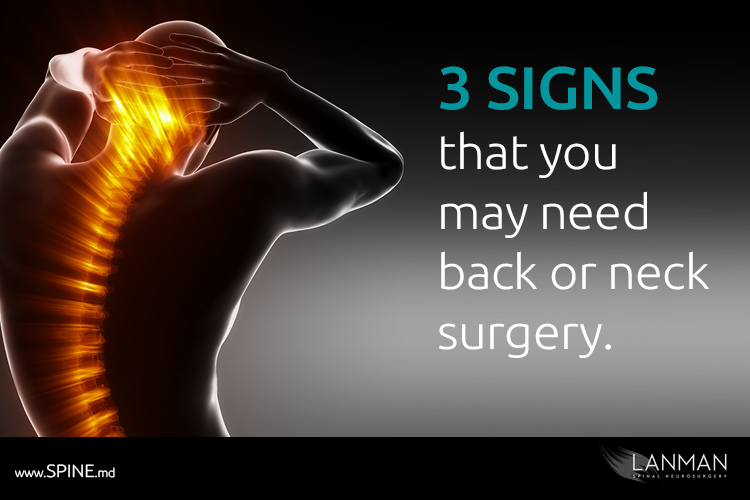Learn how to tell the difference when it’s a bit more than just a little back or neck ache.
After a long day, everyone is susceptible to a little back or neck ache. What if the pain doesn’t go away? What if it grows worse? What then?
The older you are, the more concerned you should be about back and neck problems. Once you hit age 40, any pain that doesn’t dissipate within a few days should not be taken lightly. Especially if the location of the pain is along your spine.
Like a lot of things concerning the body, the earlier you seek help from a physician about any perceived back and neck problems, the more treatment options you have and the better the potential outcomes. And many of these options do not necessarily require surgical intervention; at least, not at first. Many of my long-term patients undergo several years of what we call “conservative” therapies, which may include non-surgical treatment that involves physical therapy, fitness regimen, nutrition, supplements, and body chemistry analysis.
But when should you be concerned enough to call your doctor? You should definitely not wait until you can’t walk to get help. Here are three signs that your back and neck is signaling that it’s time to make that call.
- Numbness in your arms or legs, or your hands or feet.
- Tingling, in the same locations as the numbness.
- Weakness in your arms or legs.
Of course, these signs apply whether you have problems with your back or neck. And along with these three symptoms, you may experience soreness in the shoulder blade, leg, or along the spine. Taken together, these symptoms may indicate a pinched nerve along your spine. If the pain is sustained for 4-6 weeks, it becomes “chronic.” Chronic pain like this is not a sprain or the result of a sore muscle. You can’t shake this off. These are symptoms that a nerve is literally being squeezed by a herniated disc or abnormal bone growth (bone spur). Left untreated, the condition can eventually result in nerve loss.
The spine is an elegant chain of bones, called “vertebrae.” It is this marvelous system that gives the torso its structure vis-à-vis the ribs, while it protects the spinal cord. Segmentation of the spine is facilitated by the spinal discs located between each vertebral pair. The segments allow the body to flex, twist and bend without damage to the spinal cord. Healthy spinal discs provide the ‘glue’ that holds the structure together. They also prevent the vertebrae from bumping into one another.
For many people, discs degenerate as they age. Herniations are often the result of a sudden impact or shock to the spine such as a car accident or fall. Either way, disc failure of some kind is the most likely and most common type of spinal disorder that will cause pain and discomfort. Sometimes a patient experiences abnormal bone growth in the spine that can also impinge a nerve. Either way, the compressed nerve is painful and sometimes debilitating.
There are a few easily detectible clues that can help pinpoint where the nerve is being pinched. Nerve impingement in the cervical area may affect the arms and fingers. If in the lumbar region, then the buttocks and legs. Symptoms of this type are infrequent for the thoracic, but if they do occur, you’ll experience numbness, tingling, and pain that traverses around the mid-body and possibly into one or both legs.
Another critical thing to remember about the three signs I’ve outlined: they are progressive. Along with soreness at the location of the pinched nerve in the spine, you may first feel slight numbness. Then the numbness will progressively grow more pronounced until you also begin to feel tingling. As the condition worsens, additional symptoms may appear, such as weakness arms or legs, combined with a burning sensation in the same areas.
By the time symptoms progress to this level, you may have already suffered permanent nerve damage. And there’s nothing in medical science that can grow back damaged nerve. That’s why I say that it is better to be proactive about back and neck pain. The earlier you seek a diagnosis, the more treatment options you have. The sooner you receive treatment, the better your outcomes.







